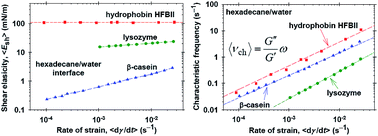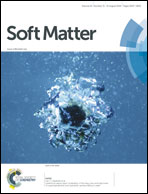Shear rheology of hydrophobin adsorption layers at oil/water interfaces and data interpretation in terms of a viscoelastic thixotropic model†
Abstract
Here, we investigate the surface shear rheology of class II HFBII hydrophobin layers at the oil/water interface. Experiments in two different dynamic regimes, at a fixed rate of strain and oscillations, have been carried out with a rotational rheometer. The rheological data obtained in both regimes comply with the same viscoelastic thixotropic model, which is used to determine the surface shear elasticity and viscosity, Esh and ηsh. Their values for HFBII at oil/water interfaces are somewhat lower than those at the air/water interface. Moreover, Esh and ηsh depend on the nature of oil, being smaller for hexadecane in comparison with soybean-oil. It is remarkable that Esh is independent of the rate of strain in the whole investigated range of shear rates. For oil/water interfaces, Esh and ηsh determined for HFBII layers are considerably greater than for other proteins, like lysozyme and β-casein. It is confirmed that the hydrophobin forms the most rigid surface layers among all investigated proteins not only for the air/water, but also for the oil/water interface. The wide applicability of the used viscoelastic thixotropic model is confirmed by analyzing data for adsorption layers at oil/water interfaces from lysozyme and β-casein – both native and cross-linked by enzyme, as well as for films from asphaltene. This model turns out to be a versatile tool for determining the surface shear elasticity and viscosity, Esh and ηsh, from experimental data for the surface storage and loss moduli, G′ and G′′.


 Please wait while we load your content...
Please wait while we load your content...